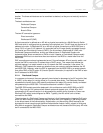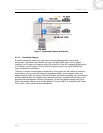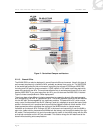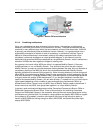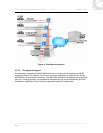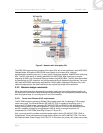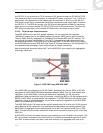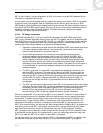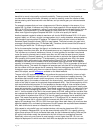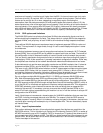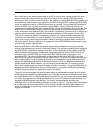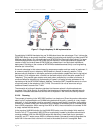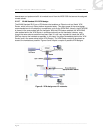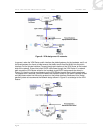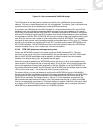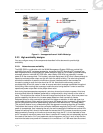
Voice over Wireless LAN Solution Guide v1.0 December 2005
______________________________________________________________________________________________________
Page 19
beneficial to overall voice quality and media scalability. These are some of the dynamics to
consider when making this choice. Ultimately you want to carefully control the number of data
devices sharing radio resources with voice devices, and you should gear your choices towards
this end.
For example, suppose that you have a large amount of Centrino laptops in the campus. If you
enable 802.11g mode, it becomes very likely that a large proportion of those laptops will prefer
802.11g (2.4 GHz) for connectivity, making it much more difficult to provide good quality voice for
handsets. If you disable 802.11g, those laptops will likely prefer 802.11a (5 GHz) because it
offers much higher throughput compared with 802.11b, and voice quality will benefit.
Another important constraint relates to maximum cell size for WLAN Handset 2210/11/12 voice
support. Ideally, an AP has a circular coverage pattern, but in reality obstacles, antenna patterns,
and orientation occlude perfect RF patterns. So instead of listing cell size in terms of distance,
Received Signal Strength Indicator (RSSI) is used instead. The outer boundary for good voice
coverage is anything better than –70 Decibels (dB). Therefore, strive to ensure that all areas of
the building are within the –70 dB range of some AP.
So far, the assumption has been that there is no interference on the 802.11b channels. But when
you deploy more than three APs, the APs themselves are a very important source of interference.
This is known as co-channel interference. Hence, it is also important to consider how channel
reuse (the term for channel plans in which more than one AP uses the same channel) impacts
network capacity. Generally speaking, you tile the channels to maximize the distance between
APs operating on the same channel. To scale capacity, you might add more APs in the same
geographic region while reducing the transmit power of each AP. But, the overall throughput
increase is not linear with the number of APs being added, meaning that total WLAN network
capacity is increased, but not proportional to the number of APs. This is an example of the law of
diminishing returns. The reason this happens is because each individual AP is losing throughput,
but the number of APs per square foot is increasing. Note that the biggest loss of per-AP
throughput occurs when going from non-channel-reuse to reusing channels. For more information
about this subject, see the
whitepaper available on the Nortel web site.
The goal of this RF engineering exercise is to achieve the required call density in terms of calls
per square foot. Getting the most calls per AP is not a useful objective of capacity planning. The
parameters that must be tuned in order to engineer a voice network for capacity are channel
reuse factor (that is, the number of channels in the channel plan), transmit power of each AP, and
radius of cell (that is, based on the physical distance between APs). Due to the complexity of this
topic and simulation data required, it is not possible to discuss tuning all three variables or even
two variables at a time. A simple case study of a light to medium office environment (mostly cube
space but some walls) is provided instead. The channel reuse factor for 802.11b networks is fixed
at three (three non-overlapping channels in the 2.4 GHz range), corresponding to channels 1, 6,
and 11, so this variable is set. We fix the transmit power to 50 mW, setting the next variable. Now
we compare the effects of cell size based on the other fixed parameters. When the deployed cells
have a radius of anywhere from 33 ft to 75 ft, the call capacity per square foot is essentially the
same. This means that packing cells in tighter than a 75 ft radius per AP is a waste of money.
This example shows that in a typical office environment with APs at half power, you should
deploy APs anywhere from 100 ft to 150 ft from each other. More walls mean you must have less
distance between APs, and lowering the power of the AP lessens the required distance between
APs, both of which also serve to increase the net call density.
With respect to voice traffic from non-handset devices, calls may be placed over 802.11a or
802.11g networks. Because 802.11g has the same channel set as 802.11b, capacity planning
allows more calls per AP due to increased data rates, but the fundamental scaling limits and per-
AP radius limits remain mostly the same due to the limit of three non-overlapping channels.
Specifically, when only one channel is used capacity is much higher than 802.11b, but in an
enterprise deployment in which more than three APs are deployed and channels are reused,



